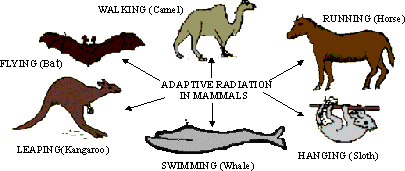|
PinkMonkey Online Study Guide-Biology
11.1 (B) Recombination as a Source of Variability
In organisms which reproduce asexually, the offsprings
are identical as they are formed by mitosis. However, in sexually
reproducing organisms the offsprings differ from their parents in many
respects. This is due to genetic recombinations. During gametogenesis,
the homologous chromosomes exchange genes by the process of crossing
over. This produces a new combination of genes. The process of fertilization
brings together genetic material from two different cells, the sperm
and the ovum, which differ in their characters. Thus genetic
recombinations take place firstly by bringing together paternal
and maternal chromosomes and secondly the by crossing-over mechanism.
This process of genetic recombination results in new variations. If during
such recombination process any advantageous characters develop, they are
passed on to the offspring generation after generation and thus contribute
to the evolution of better and strong organisms.
11.1 (C) Role of Selection
The process of natural selection plays important role in the following processes.

Figure 11.3. Industrial melanism, Biston betularia
and its black form
B carbonaria on tree trunk in (A) unpolluted
area, and (B) polluted area
(i) Variations. Variations result due to generic
recombinations. If the variations are favorable, (i.e. if they are of
some help or advantage), they are passed to the next generation. This
can be best studied with reference to certain characters. Human complexion
colors vary from almost black, through brown to white. These shades result
because of difference in the amount of melanin developed in the
skin. In tropical areas such as Africa, sunlight is intense, and melanin
develops in the skin and screens out sunís rays, yet adequate amounts
of vitamin D can still be synthesizedin the skin. In the northern areas
there is less sunlight. Less melanin is developed so that light can penetrate
the skin and synthesize vitamin D. Therefore, humans in the north of the
tropic countries tend to be lighter complected.
Industrial melanism (Figure 11.3) is another example
of favorable variations developed and selected. In the industrial areas
of Britain, the soot released from numerous factories is deposited on
the tree trunks which made them dark. The normal peppered moth, Biston
betularia, has a grey body which more closely matches with the color
of lichens on the bark of trees. Some moths have developed melanin. When
such dark moths settled on dark tree trunks, they are not noticed by predators.
But the original light-colored moths could be easily noticed and killed
by their predators and thus diminished in number gradually.
The darker variety of moth Biston carbonaria is
at advantage in this environment. They escapes predators and survive and
reproduce. Similar changes have been observed in nearly 100 other species
of insects and spiders. Thus, selection plays an important
role in choosing favorable variations.
(ii) Adaptations. Any characteristic that is advantageous
to an organism is referred to as an adaptation. Adaptations are
genetically controlled traits that help an individual to survive and produce
offspring in a particular environment. Evolution implies that the surviving
species are more adaptive than the those that do not survive. Adaptations
can be classified under three categories, structural, physiological
and behavioral adaptations. The adaptations may also be described
under the following heads when different environmental conditions are
taken into consideration. They are described as cursorial adaptations
(terrestrial adaptations especially for fast running), fossorial adaptations
(subterranean adaptations shown by diggers), aquatic adaptations
(shown by animals living in water), scansorial or arboreal adaptations
(shown by animals living in or on trees), volant adaptations (shown
by animals that can fly), cave adaptations and desert adaptations.
Depending upon environmental pressures, animals adjust
to the environmental changes. Adaptive features may result by the process
of genetic recombinations or mutations. Organisms which
show favorable variations can survive and reproduce their kind. Thus,
the adaptive features are passed on to the offspring down through generations
and in this manner new varieties develop. Selection plays important role
in allowing the new variety to survive and thus, a new species evolves
from the pre-existing simple species. The paleontological record proves
how organisms must have adapted and evolved into more fit and successful
individuals.

Figure 11.4 Adaptive radiation in mammals Adaptive radiation produces bush-like pattern of evolution
|